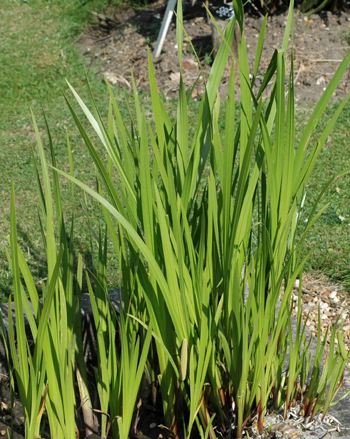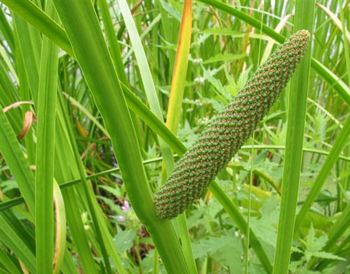Contents:
Common Names | Parts Usually Used | Plant(s) & Culture | Where Found | Medicinal Properties | Biochemical Information
Legends, Myths and Stories | Uses | Formulas or Dosages | Nutrient Content | How Sold | Warning | Bibliography
Scientific Names

- Acorus calamus L.
- Acorus Americanus
- Araceae
- Arum family
Common Names
- Calamus
- Calamus root
- Grass myrtle
- Myrtle flag
- Sea serge
- Shi-ch’ang-p’u (Chinese name)
- Sweet cane
- Sweet grass
- Sweet myrtle
- Sweet root
- Sweet rush
- Sweet rush root
- Sweet sedge
- Vacha (Sanskrit name)
Parts Usually Used
Root
Back to Top

Description of Plant(s) and Culture
Sweet flag is a strongly aromatic perennial plant; its horizontal, creeping rootstock, which may grow to 5 feet long, produces sword-shaped, striped green and yellow, cattail-like leaves, 3/4 inch wide, and 2-6 feet high, with a vertical midrib, and also a keeled or ridged, thick, fleshy flower stalk which bears a cylindrical spadix covered by minute greenish-yellow flowers. The leaf-like spathe covering the stalk continues past the spadix to the same length as the leaves. The finger-like flowerheads, jutting at an angle about 1/3 of the way up the stem, are usually found on a low percentage of plants in a given population. Flowers May to August.
Sweet flag resembles the cattail or the iris, but it is allied actually to the jack-in-the-pulpit and skunk cabbage. The entire plant has a spicy, lemon fragrance. Sweet flag also resembles the Blue flag (Iris versicolor) but it is not an Iris, however, and may be distinguished from it by its corm and the pungent taste of the leaves.
Other varieties: Variegated sweet flag (Variegatus) of either (A. calamus) 2-3 feet tall or (A. gramineus) the Japanese sweet flag, 6-12 inches tall. The variety ‘Pussilus’ is a dwarf, 5 inch plant that’s good for massing.
Back to Top
Where Found
Found more or less abundantly throughout the northern hemisphere, in pond edges, marshes, swamps, and the banks of rivers and streams.
Back to Top
Medicinal Properties
Antispasmodic, aromatic, carminative, decongestant, diaphoretic, emetic, emmenagogue, expectorant, febrifuge, nervine, sedative, stimulant, stomachic, tonic, vulnerary
Back to Top
Biochemical Information
Beta-asarone
Back to Top
Legends, Myths and Stories
It sometimes is credited with aphrodisiac powers; for an extended celebration of its properties, see Walt Whitman’s poem “Calamus”.
Sweet flag root is used in beer makings and flavorings. Roots are used in compositions to flavor gin, cordials, and some vermouths. It must be discreetly used as its aroma overpowers other fragrances. The aroma is likened to ginger and used in India when ginger is not available. It is also chewed to freshen the breath. Made into a tea, or soaked in 75% alcohol (not rubbing alcohol) for a week and then diluted, will make an excellent mouthwash.
One old herbal, Prof. Burnett remarks that sweet flag was consumed in great quantities by perfumers and the makers of hair powder. At the time of his writing, he stated that sweet flag was almost wholly destroyed in the neighborhood by their continual maraudings.
Sweet flag is a widely grown water-plant, used for rush-seating and is a bitter aromatic tonic.
Sliced roots of sweet flag were used in olden times to protect furs and woolens.
On the Chinese New Year, Cantonese cleaned out their homes and placed the sword-shaped leaves near the door. Beneath them was placed a pair of red scrolls bearing an inscription, for example: (The sweet flag, like a sword, destroy’s a thousand evil influences.)
The aroma of sweet flag is the basis for its long history in herb lore. The foliage was widely used as a strewing herb, as the aroma released under the bruising footstep could mask that of unwashed bodies. Strewn on floors in churches and public buildings on occasion of festivities. The lower stem and rhizome can be dried, cut into pieces, and used to scent drawers, closets, and chests. The whole plant has a spicy, lemon fragrance.
Sweet flag has been used as medicine for more than 2000 years. In olden times, sweet flag, or calamus, was recommended by Taoists as having the power to bestow immortality. Dioscorides mentioned that it helps the cough. And in another part of the world, not discovered until some 1400 years later, Native Americans were using sweet flag for colds.
In cooking, the sweet flag or calamus root is sometimes used as a substitute for ginger, cinnamon, or nutmeg.
Commercially, the rhizome has found its way into hair and tooth powders and beverages., including beer, bitters, tonics, liqueurs, and cordials. Today, neither dried rhizome nor essential oil of sweet flag is allowed in food in the United States because the leading component of the essential oil is said to be carcinogenic. Dried rhizomes, however, as well as dried leaves are used in potpourris, and the dried seed heads are an interesting addition to floral arrangements.
Native Americans of the Great Lakes region weave fragrant sweet flag baskets, and those of Penobscot, Maine, believed it had protective and healing powers. Wisconsin and Minnesota Indians soak their nets in an infusion made of sweet flag and sarsaparilla, for catching white fish. It is said the net still smelled of the decoction after being in water for 12 hours.
Vapors from the roots repel some insects.
The Egyptians used sweet flag for the legendary disease of scrofula, but it should be combined with supporting, more effective herbs for this chronic condition. Originally, China and India were the motherlands of Calamus, or sweet flag, which was first taken to Russia in the 11th century when the Mongolians overcame the Russian territory. Tartars (Mongolians) considered that sweet flag purified the water. When they planned on settling in a new territory, sweet flag was always planted near the watering place to ensure of pure drinking water for the horses.
Today, sweet flag is still used for its refreshing aroma. In powdered form it is used for sachet and toilet powders. The distilled oil is used in perfumery. The candied root was a popular confection in colonial times. In medicine, it is used mainly for flavoring.
Back to Top
Uses
It is particularly known for the beneficial effects on the stomach, especially heartburn with sour eructations. A few small pieces of the root being chewed and the juice swallowed, but do not swallow the pulp, will give prompt relief. The roots may be chewed several times a day for chronic conditions, until the stomach is back in good healthy working order. It stimulates the appetite and helps to relieve acute and chronic colic, gastritis, fevers, colds, sinus headaches, sinusitis, coughs, and hyperacidity, deafness, arthritis, hysteria, neuralgia, epilepsy, shock. Chewing the root is said to stop pyrosis, the discharge of an acrid liquid from the stomach into the throat. For smokers, however, chewing the dried root tends to cause mild nausea, a property that makes sweet flag useful for breaking the smoking habit. A decoction of the rootstock makes a good bath additive for insomnia, malaria, cholera, typhus, flu, bronchitis, ague, diarrhea, dysentery, asthma, a general tonic, and tense nerves; it has also been used in baths for children with scrofula or rickets. Externally, the tea is used for sores, burns, scrofula, wounds, and ulcers.
Back to Top
Formulas or Dosages
Infusion: steep 1 tsp. rootstock in 1/2 cup boiling water for 5 minutes. Take 1 cup per day.
Decoction: add 1 tbsp. dried rootstock to 1 cup simmering water and boil briefly. Take 1 cup per day.
Tincture: take 10 drops, 3 times per day.
Oil: take 2 to 3 drops, 3 times per day.
Bath additive: add 1 lb. dried rootstock to 5 qt. water; bring to a boil, then steep for 5 minutes and strain. Add to the bath water.
Capsules: take 1 per day for only 1 week at a time without a break.
Back to Top
Nutrient Content
Potassium, phosphorus
Back to Top
How Sold
Capsules
Back to Top
Warning
Preparations containing beta-asarone are restricted in the United States. Beta-asarone is a carcinogen. Under FDA restrictions, not recommended for internal usage.
Sweet flag may have some toxic effects when taken internally. It is good when used externally.
Care should be taken in cases of bleeding hemorrhoids or bleeding disorders including epistaxis.
Back to Top
Bibliography
![]() American Folk Medicine
American Folk Medicine, by Clarence Meyer, Meyerbooks, publisher, PO Box 427, Glenwood, Illinois 60425, 1973
![]() Back to Eden
Back to Eden, by Jethro Kloss; Back to Eden Publishing Co., Loma Linda, CA 92354, Original copyright 1939, revised edition 1994
![]() Chinese Medicinal Herbs
Chinese Medicinal Herbs, compiled by Shih-Chen Li, Georgetown Press, San Francisco, California, 1973.
![]() The Complete Medicinal Herbal
The Complete Medicinal Herbal, by Penelope Ody, Dorling Kindersley, Inc, 232 Madison Avenue, New York, NY 10016, First American Edition, copyright 1993
![]() Eastern/Central Medicinal Plants
Eastern/Central Medicinal Plants, by Steven Foster and James A. Duke., Houghton Mifflin Company, 215 Park Avenue South, New York, NY 10000
![]() The Herbalist Almanac
The Herbalist Almanac, by Clarence Meyer, Meyerbooks, publisher, PO Box 427, Glenwood, Illinois 60425, copyright 1988, fifth printing, 1994
![]() The Herb Book
The Herb Book, by John Lust, Bantam Books, 666 Fifth Avenue, New York, NY. copyright 1974.
Herbal Gardening, compiled by The Robison York State Herb Garden, Cornell Plantations, Matthaei Botanical Gardens of the University of Michigan, University of California Botanical Garden, Berkeley., Pantheon Books, Knopf Publishing Group, New York, 1994, first edition
 How Indians Use Wild Plants for Food, Medicine & Crafts
How Indians Use Wild Plants for Food, Medicine & Crafts, by Frances Densmore, Dover Publications, Inc., 180 Varick Street, New York, NY 10014, first printed by the United States Government Printing Office, Washington, in 1928, this Dover edition 1974
![]() Indian Herbalogy of North America
Indian Herbalogy of North America, by Alma R. Hutchens, Shambala Publications, Inc., Horticultural Hall, 300 Massachusetts Avenue, Boston, Massachusetts 02115, 1973
 Secrets of the Chinese Herbalists
Secrets of the Chinese Herbalists, by Richard Lucas, Parker Publishing Company, Inc., West Nyack, NY, 1987.
 Old Ways Rediscovered
Old Ways Rediscovered, by Clarence Meyer, Meyerbooks, publisher, PO Box 427, Glenwood, Illinois 60425, published from 1954, print 1988
![]() The Yoga of Herbs: An Ayurvedic Guide to Herbal Medicine
The Yoga of Herbs: An Ayurvedic Guide to Herbal Medicine, by Dr. David Frawley & Dr. Vasant Lad, Lotus Press, Twin Lakes, Wisconsin, Second edition, 1988.
![]() Webster’s New World Dictionary
Webster’s New World Dictionary, Third College Edition, Victoria Neufeldt, Editor in Chief, New World Dictionaries: A Division of Simon & Schuster, Inc., 15 Columbus Circle, New York, NY 10023
 The Rodale Herb Book: How to Use, Grow, and Buy Nature’s Miracle Plants (An Organic gardening and farming book)
The Rodale Herb Book: How to Use, Grow, and Buy Nature’s Miracle Plants (An Organic gardening and farming book), edited by William H. Hylton, Rodale Press, Inc. Emmaus, PA, 18049., 1974
